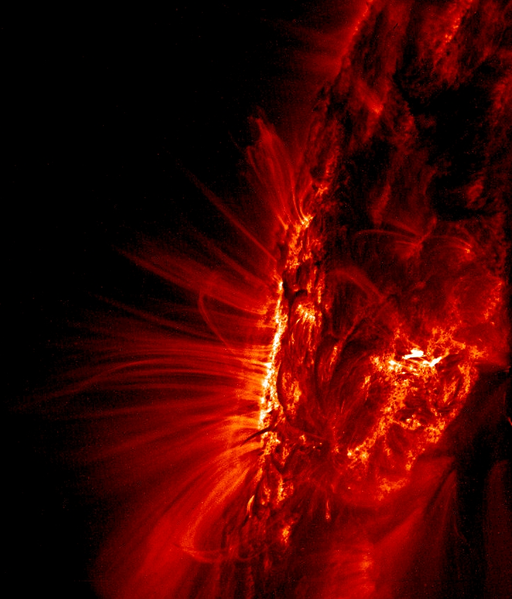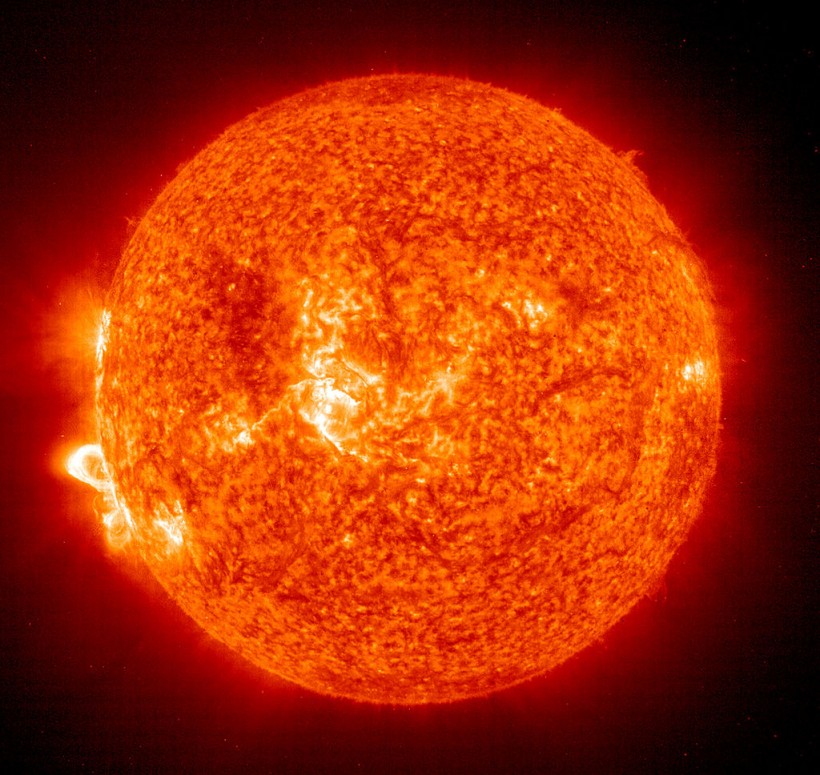High-energy radiation outbursts from the sun's atmosphere can occasionally propel blobs of plasma toward Earth.
A solar flare is an intense burst of electromagnetic radiation produced in the sun's atmosphere - the layers of sparse but hot gas that lie above the sun's visible surface, known as the photosphere.

Energy Release
Most of the energy generated by a normal solar flare is radiated away in the ultraviolet and X-ray regions of the electromagnetic (EM) spectrum, with shorter wavelengths and higher energies than visible light.
Solar flares may burn neighboring material in the sun's atmosphere, causing massive blobs of plasma launched at Earth in a phenomenon known as a coronal mass ejection.
Because the Earth's atmosphere blocks out most of these wavelengths, scientists rely on satellites and specialized sensors onboard spacecraft to detect high-energy radiation from flares.
The visible light component of a flare, on the other hand, may be seen from Earth with specialist solar-observing telescopes that filter out everything except a small range of wavelengths.
According to the American Astronomical Society, strong flares can be seen on rare occasions as bright, star-like spots of light standing out against the sun's disk when seen safely through a telescope.
"Solar flares are classified based on their brightness in soft X-rays," Stephanie Yardley, a space weather specialist at University College London's Mullard Space Science Laboratory in the United Kingdom, told Live Science.
"The weakest flares are A or B-class, while the strongest flares are C, M, or X-class. Each letter represents a factor of 10 increase in energy, and within each class, there is a number scale from 1 to 9."
The biggest event on record was the Carrington Event in 1859, which was named after English astronomer Richard Carrington, who spotted it by chance while observing the sun.
It had an estimated soft X-ray peak of X45.
Also Read: Geomagnetic Storm Watch: Will this Huge Solar Eruption Reach Earth?
Frequency of Flares

The amplitude and frequency of flares and many other features of solar activity vary during an 11-year "solar cycle."
This is the amount of time it takes for an ordered global magnetic field to form among the sun's swirling plasma, strengthen, get tangled, and finally disintegrate.
The development of magnetic field loops, sunspots, and flares is at its peak in the middle of the cycle, known as the solar maximum.
The number of flares is growing dramatically as the current solar maximum, which is predicted to occur around 2024, approaches.
Flare Development
Flares arise where magnetic field loops pass through the solar atmosphere.
These loops, created by the churning of plasma (electrically charged hot gas) inside the sun, push through the surface.
Cooler portions at their entrance and departure points show as black sunspots among the hotter, brighter gas, while the loops convey relatively cool gas along with them, appearing as dark "filaments" when silhouetted against the photosphere or as pinkish prominences around the sun's edge or limb (best seen during a total solar eclipse).
A flare develops when the lower sections of a magnetic loop become squeezed together in the lower corona of the atmosphere.
This causes the magnetic field to "short circuit," rejoining significantly closer to the surface and ripping the material above away.
Because a magnetic loop high above the surface contains significantly more energy than one lower below. These reconnection events have the potential to release massive amounts of surplus energy.
This raises the temperature of the solar atmosphere around the reconnection site to 50 to 68 million degrees Fahrenheit (10 to 20 million degrees Celsius), well beyond the typical 2 million F (1 million C).
Solar "Flare"
The term "flare" is used by astronomers to describe a burst of energy and radiation on the sun, but it is also connected with a range of other events.
For example, material heated by the flare in the solar atmosphere may continue to expand furiously, eventually generating a coronal mass ejection, or CME, a massive cloud of particles blasted out in a precise direction that may take several days to reach Earth's orbit.
The most powerful flares also cause a solar proton storm, which occurs when the shock from an expanding CME accelerates nearby protons (subatomic charged particles), driving them forth at far faster velocities than the CME itself.
In some situations, if the sun's magnetic field is oriented favorably, protons can travel at a significant percentage of the speed of light.
A flare's electromagnetic radiation reaches Earth in slightly over 8 minutes, while proton storms may arrive in as little as 30 minutes.
Related Article: Can We Survive a Catastrophic Solar Storm? What to do When a Solar Flare Hits Earth
For more cosmic news, don't forget to follow Nature World News!
© 2024 NatureWorldNews.com All rights reserved. Do not reproduce without permission.

![Tsunami Hazard Zones: New US Map Shows Places at Risk of Flooding and Tsunamis Amid Rising Sea Levels [NOAA]](https://1471793142.rsc.cdn77.org/data/thumbs/full/70325/280/157/50/40/tsunami-hazard-zones-new-us-map-shows-places-at-risk-of-flooding-and-tsunamis-amid-rising-sea-levels-noaa.jpg)



